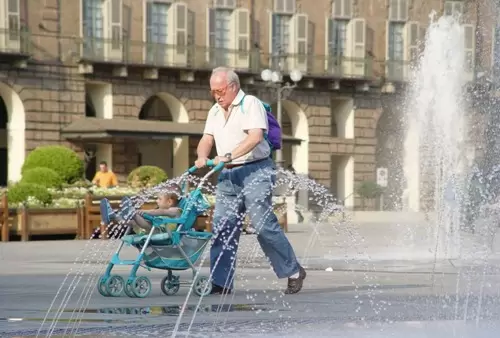There is no prescription to prevent, solve or alleviate the impairments of old age, says new book
23-July-2016
Vol 7 | Issue 30
Active and healthy ageing is the new creed. But how can we achieve that, and how can we shape our new, longer lives? Old people’s own perception of their state of health and the quality of their lives is extremely important. Research has shown that social contacts are crucial for their well being, as well as an ability to adjust constantly to changed circumstances, including the decline in their physical and cognitive abilities.
In Growing Older Without Feeling Old: On Vitality And Ageing, published by Speaking Tiger, Rudi Westendorp, one of the world’s leading experts in geriatric medicine, explores the causes of ageing and explains how people can greet it with confidence to enjoy longer, healthier and more productive lives than ever before. An excerpt.
 |
|
The real answer to the question of how to grow old without being old lies in our own social and psychological flexibility, says the author (Photo: FreeImages.com/ Luca Cinacchio - for representational purpose only)
|
‘Is there a prescription for growing old without being old?’ I am often asked this question, and it always makes me feel a little uncomfortable. I do not have a simple prescription that would prevent, solve, or alleviate the impairments associated with old age. There is no miracle cure, and it is not likely that there ever will be. The causes of the damage that arises due to the ageing process are simply too complex and multifaceted.
How different that is from the message we get from the anti-ageing industry. It makes convenient use of what we all want to hear: that the ageing process can be prevented, or at least slowed, by using the product being touted.
There are countless special diets that ‘gurus’ claim can keep you young. There is, however, no evidence for their claims. Fortunately for us, the quality of our food is better than ever before, in the sense that it is not contaminated, toxic, or rotten. Many harmful ingredients have been banned by law. The problem we face today is that we consume too much of some substances and too little of others. Our food often contains too much salt, fat, or sugar, and many of us do not eat enough fruit and vegetables.
Nutrition is a complex matter, and experts have great difficulty in formulating precise guidelines. Their advice is highly subject to the vagaries of fashion. Remember the nineteen-eighties and nineteen-nineties, when we were confidently informed that every egg we ate took us one step closer to a heart attack. Now we are allowed to enjoy an egg for breakfast every day. Twenty years ago it was impossible to get hold of butter or bacon in an American hotel; whole grains in all shapes and sizes were the standard. Now, you see Americans tucking into their bacon and eggs every morning, and carbohydrates are the new bad guys. For now, the best advice seems to be to eat a varied diet that includes a little bit of everything. ‘Colourful eating’ is the new buzzword.
Should we then just sit around idly, waiting until it’s time for our final curtain call? Of course not. We can change our lifestyle at any time if it is negatively affecting our health. It is never too early and never too late to start. So why does it go wrong so often? Why are we too fat, why do we drink too much, cycle too little, and stubbornly refuse to give up smoking? Presumably, people underestimate the extent to which the environment we live and work in impacts on us. Advertisers constantly send out massive stimuli to influence our behaviour in a particular direction — often the wrong one. Take electric bikes, for example, the new must-have gadget among older people, which have been promoted massively in many developed countries. But why not just keep cycling the normal way, pedalling under your own power until you get tired? The adverts have the answer: ‘Why tire yourself out pedalling when you can buy an e-bike?’ Unless you use an e-bike instead of taking the car, it stops you from doing what you should: taking active exercise. Riding a real bike requires exertion, but you get a lot in return: health benefits from the positive stress on your heart, lungs, muscles, and joints, as well as an adrenaline rush. If there is one thing that researchers agree on, it is that a sedentary, inactive lifestyle should be avoided at all costs. …
When it comes down to it, there is no way to prevent impairment to our bodies and brains. In the preceding chapters, I have shown the possibilities currently offered by medical technology and biomedicine for prolonging our functional life. Whatever impairments we develop after the age of 50, they are increasingly repairable. Medical technicians are chomping at the bit to come up with new hips, valves, and lenses. They are busy developing implantable devices to support a faltering heart, and perhaps one day even replace it. Fatal bleeding can be prevented by putting ingenious plastic pipes into dilated blood vessels. It will not be long before we all have a new little microphone implanted in our ear as soon as the built in one we were born with fails due to ageing. …
But are the physical and mental limitations of blind or deaf people, for example, really a disaster always to be prevented? Experience teaches us that most older people do not (want to) take that decision when the time comes. Unfortunately, loved ones and professionals do not always react correctly to increasing impairment. All too often, physical dependency is seen as sufficient reason to write someone off as non-active and to take over control of their lives. This robs a person of their independence and dignity.
In the final, vulnerable stage of their lives, in particular, vitality is necessary if older people are to make their day-to-day life enjoyable. This is all the more true of people who are less able to look after themselves, for whatever reason. In that case, they need someone — a loved one or
a professional — to help them fulfil their wishes and meet their needs.
Fortunately, most older people are able to run their own lives. Their failing bodies are then ‘merely’ flaws they can easily live with. Since many older people no longer see their physical, and often also their mental, limitations as a burden, they feel ‘unbound’.
The real answer to the question of how to grow old without being old lies in our own social and psychological flexibility. Old people show us that. Again and again, I am struck by older people who have managed to retain their vitality and sense of wellbeing, despite impairment and limitations.
Aafje is just such a person. At 96, she is a phenomenon. She can often be seen riding around the neighbourhood where I live on her conspicuous scooter, which she handles with skill. You can see her outside the nursing home, or sipping an espresso on the café terrace. At the baker’s she chats with the other customers in the queue. On many occasions I have seen her whizz by in a taxi, a woman on a mission: to get her hair done.
I have also met Aafje a couple of times in my professional capacity. Not that she came to my surgery with a medical complaint; she came to tell people how best to get old. At the Leyden Academy, we organise meetings with older people as part of our course for care professionals. These carers often focus on organisation rather than on the old people they care for. Aafje was one of the ‘experience experts’ invited to come and tell the course participants how old people can deal with loss, illness, and impairment, and a stiff and leaky body, and still run their own lives and retain their dignity. She had lost her husband and had had to move out of her ‘gorgeous’ house. She was no longer able to live alone at home, despite the army of helpers she had drummed up. Dressing and undressing — let alone getting in and out of the shower — were no longer possible without help. However, with her mischievous smile and her freshly coiffed hair, Aafje made a fragile but unforgettable impression. ‘Let it go,’ she told us. ‘You have to let it all go.’
(Excerpted from Growing Older Without Feeling Old: On Vitality And Ageing by Rudi Westendorp; Published by Speaking Tiger, Pp: 266; Price: Rs 399.) - Women's Feature Service














